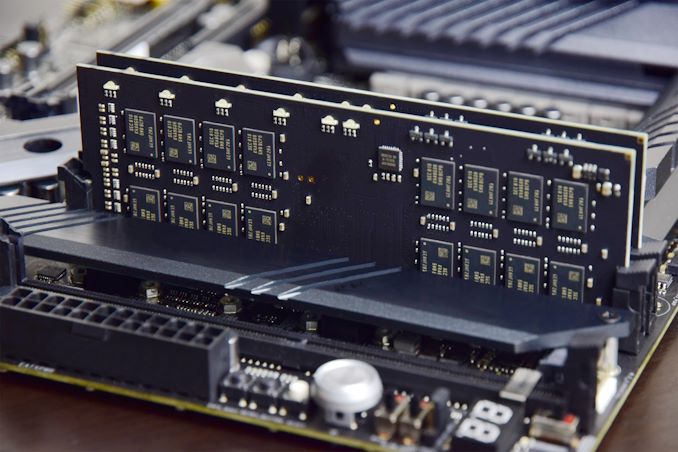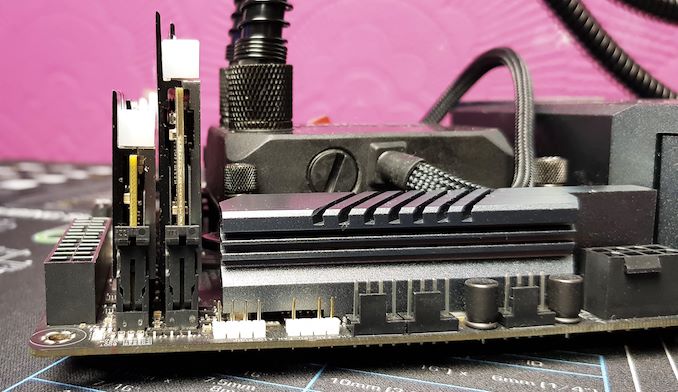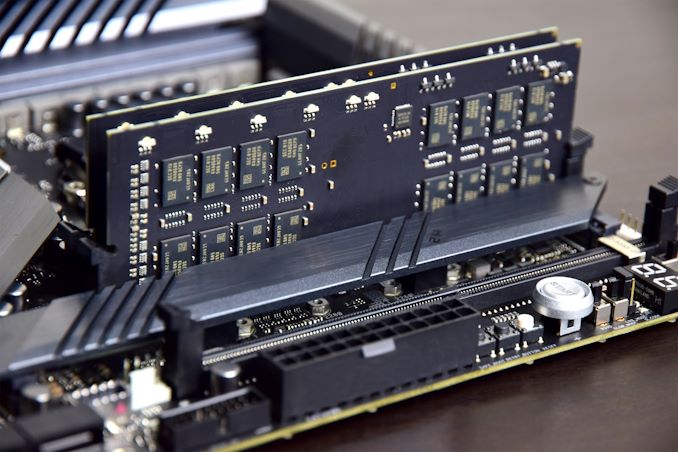Double Height DDR4: 32GB Modules from G.Skill and ZADAK Reviewed
by Ian Cutress & Gavin Bonshor on January 23, 2019 9:00 AM EST
Two memory module companies, G.Skill and ZADAK, have developed a new memory format with double capacity DDR4 memory. These new modules put the equivalent of two standard modules onto one PCB, making one memory module act like two. Both companies have introduced 2x32 GB kits. As a result, these memory modules are double the capacity over regular DDR4 memory, with the downside that they are also double the height. We have tested both of the available kits using this technique, both coming in at DDR4-3200: the G.Skill TridentZ RGB DC DDR4-3200 and the ZADAK Shield RGB DC DDR4-3200.
Double Height Memory?
One of the disadvantages of small form factor motherboards is that they only feature two memory slots. Most consumer DDR4 modules can have a maximum capacity of 16 GB per module, which for mini-ITX would mean a maximum capacity of 32 GB. For ATX motherboards, this usually means a maximum capacity of 64 GB. Users looking to build those small form factor systems have historically been capped to 32 GB - these new modules doubles that capacity to 64 GB.
There are currently three motherboards on the market validated for this new double height memory:
- ASUS ROG Maximus XI Apex (Z390)
- ASUS ROG Maximus XI Gene (Z390)
- ASUS ROG Strix Z390-I Gaming
These are all Z390 chipset motherboards, and thus applies to Intel's 8th Gen and 9th Gen processors. In this review we used an i7-8700K, and it didn't have any issues. We tested on some other motherboards from MSI and ASRock, however those systems did not post. It would appear that the memory has been developed in conjuction with concurrent validation with ASUS.

Left to Right: ZADAK Shield RGB DC, G.Skill TridentZ RGB DC,
G.Skill TridentZ RGB & Corsair Vengeance LPX
Each memory company is only offering a select number of kits, presumably due to the low catchment rate of the motherboards they are validated for, but also likely due to cost.
G.Skill is offering three different 'TridentZ RGB DC' memory kits, each 2x32 GB:
- G.Skill TridentZ RGB DC DDR4-3000 CL14
- G.Skill TridentZ RGB DC DDR4-3200 CL14
- G.Skill TridentZ RGB DC DDR4-3200 CL14 (looser secondary latencies)
ZADAK by contrast is offering five 'Shield RGB DC' memory kits, each 2x32 GB:
- ZADAK Shield RGB DC DDR4-2666 CL16
- ZADAK Shield RGB DC DDR4-3000 CL16
- ZADAK Shield RGB DC DDR4-3200 CL16
- ZADAK Shield RGB DC DDR4-3200 CL14
- ZADAK Shield RGB DC DDR4-3600 CL16
All of these kits (except ZADAK's DDR4-2666) have a rated voltage of 1.35 V. G.Skill's kits do not have associated MSRPs due to the way G.Skill operates, however ZADAK has shared that their memory kits will start from an MSRP of $800.
The benefit of dense(r) memory is thatmotherboards can double up on maximum capacity without needing four memory slots. All three motherboards listed, the Apex, Gene, and the Z390-I Gaming, only have two memory slots which makes them ideal targets, even though only one is mini-ITX and the other two could have had four memory slots in place. The reason why only these ASUS motherboards are supported at this time is due to the collaboration between the companies: ZADAK says the modules were 'co-developed', but failed to go into detail about who designed what. Nonetheless, these modules are ASUS exclusive for the time being.
Double Height: Cooler Selection
Using memory that is double the height of a normal module, certain other restrictions come into play: namely the CPU cooler being used has less room to exist.
The almost universal intention in this environment, unless a low powered CPU is used, is for a liquid cooler to be in play.
Under The Heatsinks
We'll go into more detail on the specific kits over the page, but both memory modules work in a similar fashion.
Using 8 Gb Samsung B-die chips, a normal 16 GB module would have 16 of them to make it up to capacity. For these modules, to reach 32 GB per module, there are 32 x 8 gigabit chips. These are split into two ranks of sixteen chips, and act as if there are two memory modules on the same channel. Modern mainstream processors support 'two DIMMs per channel', meaning two memory modules per channel, which is why we see motherboards for dual channel processors have a total of four slots. By putting two modules onto one PCB, only one slot is needed to hit 'two DIMMs per channel'.
One would assume the signalling would be different, however within the same channel, a normal set of memory modules would use the same traces and either (a) daisy chain, or (b) split near the end in order to support both simulateously. There are stability advantages to the (b) method, known as T-Topology, however it is often more difficult to do. Either way, because two memory modules on the same channel do not need separate motherboard traces, that is what makes these modules possible. There are some additional fine tuning elements to the system as well, as with all memory.
Ultimately any memory vendor's chips could have been used, but both G.Skill and ZADAK have gone with Samsung B-die, which are known for being good overclocking-focused memory. It likely also helps that the optimizations for one company's kit also helped with the second, as different ICs would have different requirements in the firmware.
Ultimately with this review, we want to answer the following questions:
- Is there any performance difference against normal 16GB modules, and
- How is the power draw affected?
The goal for both answers should be negative: we shouldn't expect any performance difference and no power difference. We also do some overclocking to see if they can be pushed harder even in this form factor.
Test Bed and Methodology
| Test Setup | |||
| Processor | Intel i7-8700K, 95W, $359 / 1ku 6 Cores, 12 Threads, 3.7 GHz (4.7 GHz Turbo) |
||
| Motherboard | ASUS ROG Strix Z390-I Gaming (BIOS Version 1003) | ||
| Cooling | Corsair H100i V2 | ||
| Power Supply | Thermaltake Toughpower Grand 1200W Gold PSU | ||
| Memory Tested | 2x32GB G.Skill TridentZ DC RGB DDR4-3200 CL14 (1.35 V) 2x32GB ZADAK Shield DC RGB DDR4-3200 CL14 (1.35 V) 2x16GB G.Skill TridentZ RGB DDR4-3200 CL14 (1.35 V) 2x16GB Corsair Vengeance LPX DDR4-2400 CL14 (1.2 V) 2x8GB TeamGroup Night Hawk RGB DDR4-3000 CL16 (1.35 V) |
||
| Video Card | ASUS GTX 980 STRIX (1178/1279 Boost) | ||
| Hard Drive | Crucial MX300 1TB | ||
| Case | Open Test Bed | ||
| Operating System | Windows 10 RS3 inc. Spectre/Meltdown Patches | ||
New Test Suite: Spectre and Meltdown Hardened
Our motherboard benchmarking suite which includes our short form CPU performance tests and gaming tests were selected in conjunction with our new 2019 bench suite. Our test bench OS has been updated with drivers, newer software and as with our CPU testing updates, also includes Spectre and Meltdown patches.
Pages In This Review
- Double Capacity, Double Height RAM [this page]
- G.Skill TridentZ RGB DC Overview: Analysis of the Board Components
- ZADAK Shield RGB DC Aura2 Overview : Looking that the non-hardware portion
- CPU Performance
- Gaming Performance
- Power Analysis
- Overclocking Performance
- Conclusion












50 Comments
View All Comments
prateekprakash - Thursday, January 24, 2019 - link
Could you please mention the names of the motherboards which did not post with these memories?Also could you please try these with Intel 6xxx/ 7xxx series CPUs with 2xx chipsets ( z270, b250).
mito0815 - Thursday, January 24, 2019 - link
Any thoughts on how scalable this apporach is? I mean...the obvious issues (heatsink fan clearance being one of them) aside, 4-row-high-DIMMs would look absolutely hilarious. I'd buy them. Just for the joke.KarlKastor - Thursday, January 24, 2019 - link
I don't get why there is a need for double height.There are lots of DIMMs in the market, that have 18 ICs per side on a regular DIMM.
I think it's just marketing, to show visually they have something new. The Cooler occupies the space anyway. But don't get, why every Tech-website mention it's neccessary.
Targon - Thursday, January 24, 2019 - link
I suspect it is all about the memory density. So, rather than trying to get 7nm fab process RAM, these companies are using less expensive chips and just increasing the size of the board to compensate, plus the need to connect the RAM chips on the DIMM. What sort of timings are on these things, 2T, 3T, or 4T for the command rate? How about the latency ratings?KarlKastor - Friday, January 25, 2019 - link
Mh? I talk not about the number of DRAM Dies. I speak just about the size of the PCB. What has lithographie to do with PCB size?Here u have 16 packages per side. There are a lot of normal sized DIMMs outside with that amount of packages.
Danvelopment - Friday, January 25, 2019 - link
What are the use cases? I would have thought that, by the time you need those sort of capacities, you would be better served by a quad channel Xeon.NoSoMo - Friday, January 25, 2019 - link
Interesting -- now if they could just pair them with some 3D nand and allow hybrid RAM / storage like intel wants to do with optane. Perhaps it'd come in a variant that sees 16GB PC 3000 and a slot similar to M.2 with capacities that mirror that of NVMEs thus moving storage over to the RAM bus and freeing up the PCI bus. The modules would be L shaped so that the storage addition completes the form factor thus allowing it to retain the same profile as these taller units, vs having a module hanging off the side.13Gigatons - Wednesday, January 30, 2019 - link
Maybe they could focus on lowering the price????Other then that what is the case use?
DPete27 - Tuesday, February 12, 2019 - link
You can fit 2 SODIMMs using a single locking mechanism on each end within the limits of a mITX board. Surely that would be much easier and more universal.[img]https://lh3.googleusercontent.com/-L0fCpsbFSWA/We5...[/img]
ExclamationMediaLLC - Wednesday, July 10, 2019 - link
Hi Ian and Gavin! Very helpful article! I’m building a SFF workstation using these modules. I want to remove the heat spreaders but I’m afraid of damaging the DIMMs. I see you guys managed it. How risky is it? Is there anything special I should know about removing the RGB lighting strips? (Yes, everyone, I know it will void the warranty)